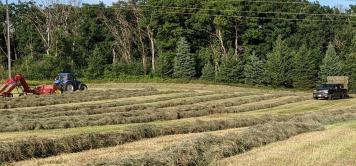WHAT GOES IN IS WHAT COMES OUT
Apr 12, 2021

Nutrient management doesn’t just apply to corn and soybeans. “It pays to fertilize hay fields,” said Mike Slater, agronomy sales rep at Federated’s Isanti location, “because what goes in is what comes out.”
“Hay continues to be a high-value crop,” he said, even with the softer market due to last year’s above average growing season. Hay continues to bring more per bale than corn is bringing in per bushel, with “yields capable of topping corn yields,” Slater noted.
Hay needs nutrients. “Hay is one of the easiest crops to mine out the soil (deplete it of nutrients),” said Slater. “Every time it is cut and baled, the entire crop is removed; compound this across two to three cuttings and you are removing more nutrients than a 200-bushel corn crop,” he said. Compare:
A 200-bushel corn crop (not counting nutrients removed by the stover) removes approximately:
- 135 lbs./ac. nitrogen
- 70 lbs./ac. phosphorus
- 15 lbs./ac. potassium
- 16 lbs./ac. sulfur
A 4.5-ton (180, 50-lb. bales/ac.) hay crop of a grass mix (Orchard, Fescue, Brome) removes roughly:
- 150 lbs./ac. nitrogen
- 55 lbs./ac. phosphorus
- 225 lbs./ac. potassium
- 25 lbs./ac. sulfur
This comparison is of nutrient removal alone – not the recommended replacement rates, which would be based on soil samples “to see what we have for a starting point,” said Slater.
Hay fertilization is best done multiple times over the season, between crops, to spread both costs and nutrients across the growing season.
Foliar feeding with a plant growth regulator – such as Triad™ or VersaMaxAC® – is another way to boost yields and improve overall plant health, especially on alfalfa and alfalfa-grass mix fields. Plus, “when already spraying an insecticide, [the foliar feeding] gets a free trip across the field,” said Slater.
Contact your Federated Agronomist for hay and/or alfalfa fertilizer recommendations.